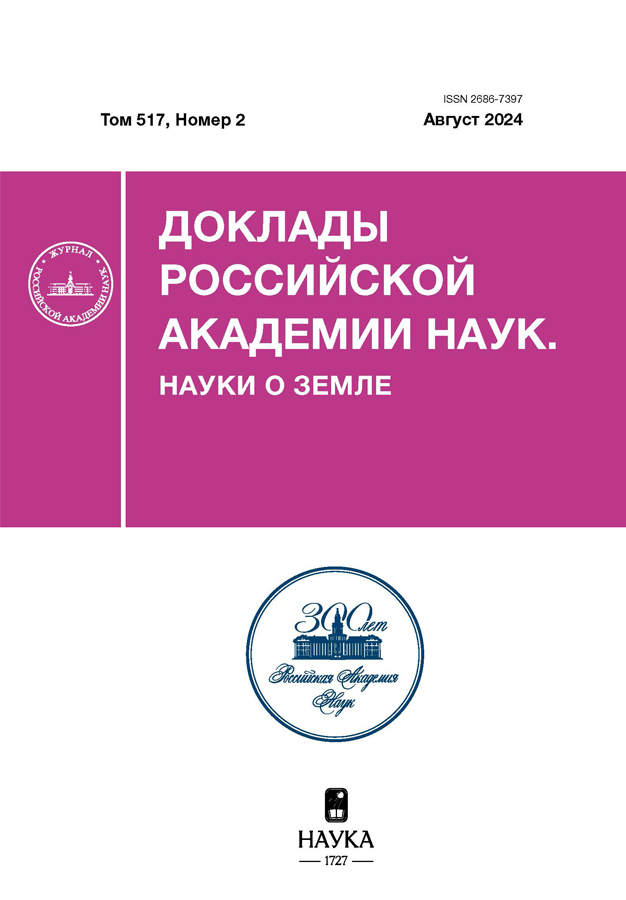Stress state and mechanics of glacier shelvescollapse
- 作者: Garagash I.A.1, Lobkovsky L.I.2, Baranov А.А.1
-
隶属关系:
- Schmidt Institute of Physics of the Earth, Russian Academy of Sciences
- P.P. Shirshov Institute of Oceanology, Russian Academy of Sciences
- 期: 卷 517, 编号 2 (2024)
- 页面: 332-338
- 栏目: GLACIOLOGY
- ##submission.dateSubmitted##: 31.01.2025
- ##submission.datePublished##: 29.12.2024
- URL: https://snv63.ru/2686-7397/article/view/649991
- DOI: https://doi.org/10.31857/S2686739724080169
- ID: 649991
如何引用文章
详细
The stress state of ice shelves using numerical modeling is studied. An ice shelf is modeled by an elastic plate floating on water and attached to the ice cover at a grounding point. An analytical solution for the elastic bending of the plate is obtained and it is shown that the maximum tensile stresses on the lower surface of the glacier near the grounding point can reach values of 5×107 Pa, significantly exceeding the limiting strength values of the glacier. The fragmentation of a glacier that occurs when a glacier moves under conditions of constrained compression has been studied. It is shown that deformations of the ice plate are accompanied by the formation of zones of localization of inelastic deformations (ice ridges). A comparison was made of the calculated relief of the plate surface after localization of deformations with the pattern of hummocking of the Larsen Glacier, visible on satellite images.
全文:
作者简介
I. Garagash
Schmidt Institute of Physics of the Earth, Russian Academy of Sciences
Email: aabaranov@gmail.com
俄罗斯联邦, Moscow
L. Lobkovsky
P.P. Shirshov Institute of Oceanology, Russian Academy of Sciences
Email: aabaranov@gmail.com
Academician of the RAS
俄罗斯联邦, MoscowА. Baranov
Schmidt Institute of Physics of the Earth, Russian Academy of Sciences
编辑信件的主要联系方式.
Email: aabaranov@gmail.com
俄罗斯联邦, Moscow
参考
- Jenkins A., Holland D. Melting of floating ice and sea level rise // Geophysical Research Letters. 2007. V. 34. L16609.
- Hansen J., Ruedy R., Sato M., Lo K. Global surface temperature change // Rev. Geophys. 2010. V. 48. RG4004. doi: 10.1029/2010RG000345.
- Scambos T. A., Bohlander J. A., Shuman C. A. et al. Glacier acceleration and thinning after ice shelf collapse in the Larsen B embayment, Antarctica // Geophysical Research Letters. 2004. V. 31. L18402.
- Christie F. D. W., Benham T. J., Batchelor C. L. et al. Antarctic ice-shelf advance driven by anomalous at mospheric and sea-ice circulation // Nature Geo science. 2022. V. 15. P. 356–362.
- Bindschadler R., Choi H., Wichlacz A. et al. Getting around Antarctica: New high-resolution mappings of the grounded and freely-floating boundaries of the Antarctic ice sheet created for the International Polar Year // Cryosphere. 2011. V. 5. P. 569–588.
- Rosier S., Gudmundsson G. Tidal bending of ice shelves as a mechanism for large-scale temporal variations in ice flow // Cryosphere. 2018. V. 12. P. 1699–1713.
- Holdsworth G., Glynn J. Iceberg calving from floating glaciers by a vibrating mechanism // Nature. 1978. V. 274. P. 464–466.
- Shebalin P., Baranov A. Aftershock Rate Changes at Different Ocean Tide Heights // Frontiers in Earth Science. 2020. V. 8. doi: 10.3389/feart.2020.559624.
- Winkelmann R., Martin M., Haselof M., Albrecht T., Bueler E., Khroulev C., Levermann A. The Potsdam Parallel Ice Sheet Model (PISM-PIK)—Part 1: Model description // Cryosphere. 2011. V. 5. P. 715–726.
- Тимошенко С. П., Войновский-Кригер С. Пластинки и оболочки. М.: Наука, 1966. 635 с.
- Petrovic J. J. Mechanical properties of ice and snow // Journal of Materials Science. 2003. V. 38. P. 1–6.
- Fish A. M., Zaretsky Y. K. Ice Strength as a Function of Hydrostatic Pressure and Temperature; CRREL Report 97-6; U.S. Army Corps of Engineers: Washington, DC, USA, 1997. P. 14.
- Богоявленский В. И., Гарагаш И. А. Обоснование процесса образования кратеров газового выброса в Арктике математическим моделированием // Арктика: экология и экономика. 2015. № 3(19). С. 12–17.
- Rudnicki J. W., Rice J. R. Conditions for localization of deformation in pressure-sensitive dilatant materials // Journal of the Mechanics and Physics of Solids. 1975. V. 23. P. 371–390.
- Garagash I. A., Nikolaevskii V. N. Non-associated flow laws and plastic strain localization // Advances in mechanical engineering. 1989. V. 12. P. 131–183.
- Itasca Consulting Group, Inc. FLAC3D—Fast Lagran gian Analysis of Continua in 3 Dimension; Version 3.1, User’s Manual. Itasca, Minneapolis, MN, USA, 2006.
- Лобковский Л. И., Баранов А. А., Владимирова И. С., Алексеев Д. А. Сильнейшие землетрясения и деформационные волны как возможные триггеры потепления климата в Арктике и разрушения ледников в Антарктике // Вестник РАН. 2023. Т. 93. № 6. С. 526–538.
- Лобковский Л. И., Баранов А. А., Владимирова И. С., Габсатаров Ю. В., Алексеев Д. А. Возможный сейсмогенно-триггерный механизм эмиссии метана, разрушения ледников и потепления климата в Арктике и Антарктике // Физика Земли. 2023. № 3. C. 33–47.
- Гарагаш И. А., Лобковский Л. И. Деформационные тектонические волны как возможный триггерный механизм активизации эмиссии метана в Арктике // Арктика: экология и экономика. 2021. № 1. С. 42–50.
- Гарагаш И. А. Быстрые изменения напряженного состояния в зоне разлома с точки зрения механики систем с несмежными формами равновесия / Тезисы докл. IV Всероссийской конференции с международным участием “Триггерные эффекты в геосистемах”. М., 2017. С. 24.
补充文件















